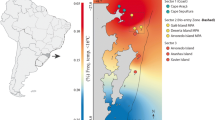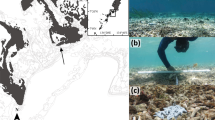Abstract
Resource use by five sympatric species of parrotfish was quantified in the San Blas Archipelago of the Republic of Panama from March to August 1987. Detailed observations of parrotfishes on patch reefs and surrounding seagrass beds showed that they partition resources with respect to habitat, food and size, but not time. Although parrotfishes shared resources, the proportions of each resource used differed significantly among species. Scarus iserti (Bloch) scraped filamentous microalgae that grew from eroded coral pavement on lower slopes of patch reefs and in “halos,” the area of sparse vegetation surrounding reefs. Sparisoma viride (Bonnaterre) foraged on upper slopes of patch reefs where they mostly took bites from dead coral and associated algae. S. aurofrenatum (Cuvier and Valenciennes) had the broadest diet, which consisted mostly of seagrasses and macro- and microalgae that were attached to dead coral on lower reef slopes and in halos. Although S. chrysopterum (Bloch and Schneider) commonly occurred on patch reefs, it primarily foraged in seagrass beds that surround them. S. rubripinne (Cuvier and Valenciennes) was distributed most widely, ranging from seagrass beds to reef crests, where it took bites from seagrasses, dead coral and macroalgae. Juveniles of all species occurred on lower slopes or in halos where they scraped filamentous microalgae from coral pavement. As they matured, parrotfishes moved into other habitats changing access to different types of food. All of these parrotfishes fed throughout the daytime, and resource use did not differ between morning and afternoon.
Similar content being viewed by others
References
Alley TR (1982) Competition theory, evolution and the concept of ecological niche. Acta biotheor 31: 165–179
Barlow GW (1975) On the sociobiology of four Puerto Rican parrotfishes (Scaridae). Mar Biol 33: 281–293
Bellwood DR (1988) Ontogenetic changes in the diet of early postsettlement Scarus species (Pisces: Scaridae). J Fish Biol 33: 213–219
Bellwood DR, Choat JH (1990) A functional analysis of grazing in parrotfishes (family Scaridae): the ecological implications. Envir Biol Fish 28: 189–214
Branch GM (1984) Competition between marine organisms: ecological and evolutionary implications. Oceanogr mar Biol A Rev 22: 429–593
Brock RE (1954) A method of estimating reef fish populations. J Wildl Mgmt 18: 297–308
Brock RE (1982) A critique of the visual census method for assessing coral reef fish populations. Bull mar Sci 32: 269–276
Bruggemann JH, van Oppen MJH, Breeman AM (1994) Foraging by the stoplight parrotfish Sparisoma viride. I. Food selection in different, socially determined habitats. Mar Ecol Prog Ser 106: 41–55
Carpenter RC (1986) Partitioning herbivory and its effects on coral reef algal communities. Ecol Monogr 56: 345–363
Carpenter RC (1988) Mass mortality of a Caribbean sea urchin: immediate effects on community metabolism and other herbivores. Proc natn Acad Sci USA 85: 511–514
Carpenter RC (1990) Mass mortality of Diadema antillarum. II. Effects on population densities and grazing intensity of parrotfishes and surgeonfishes. Mar Biol 104: 79–86
Choat JH (1969) Studies on the biology of labroid fishes (Labridae and Scaridae) at Heron Island, Great Barrier Reef. PhD dissertation, University of Queensland, Australia
Choat JH (1991) The biology of herbivorous fishes on coral reefs. In: Sale PF (ed) The ecology of fishes on coral reefs. Academic Press, New York, pp 120–155
Choat JH, Robertson DR (1975) Protogynous hermaphroditism in fishes of the family Scaridae. In: Reinboth R (ed) Intersexuality in the animal kingdom. Springer-Verlag, Heidelberg
Clarke RD (1977) Habitat distribution and species diversity of chaetodontid and pomacentrid fishes near Bimini, Bahamas. Mar Biol 40: 277–289
Colin PL (1978) Daily and summer/winter variation in mass spawning of the striped parrotfish Scarus croicensus. Fish Bull US 76: 117–124
Connell JH (1980) Diversity and coevolution of competitors, or the ghost of competition past. Oikos 35: 131–138
Connell JH (1983) On the prevalence and relative importance of interspecific competition: evidence from field experiments. Am Nat 122: 661–696
Ebeling AW, Hixon MA (1991) Tropical and temperate reef fishes: comparison of community structures. In: Sale PF (ed) The ecology of fishes on coral reefs. Academic Press, New York, pp 509–563
Frydl P, Stearn CW (1978) Rate of bioerosion by parrotfish in Barbados reef environments. J sedim Petrol 48: 1149–1158
Hay ME (1991) Fish-seaweed interactions on coral reefs: effects of herbivorous fishes and adaptations of their prey. In: Sale PF (ed) The ecology of fishes on coral reefs. Academic Press, New York, pp 96–119
Hay ME, Taylor PR (1985) Competition between herbivorous fishes and urchins on Caribbean reefs. Oecologia 65: 591–598
Hiatt RW, Strasburg DW (1960) Ecological relationships of the fish fauna on coral reefs of the Marshall Islands. Ecol Monogr 30: 65–127
Johannes RE (1981) Words of the lagoon: fishing and marine lore in the Palau District of Micronesia. University of California, Berkeley
Lessios HA (1988a) Mass mortality of Diadema antillarum in the Caribbean: what have we learned? A Rev Ecol Syst 19: 371–393
Lessios HA (1988b) Population dynamics of Diadema antillarum (Echinodermata: Echinoidea) following mass mortality in Panama. Mar Biol 99: 515–526
Lewis SM, Wainwright PC (1985) Herbivore abundance and grazing intensity on a Caribbean coral reef. J exp mar Biol Ecol 87: 215–228
Littler MM, Littler DS (1984) Relationships between macroalgal functional form groups and substrata stability in a subtropical rocky intertidal system. J exp mar Biol Ecol 74: 13–34
Littler MM, Taylor PR, Littler DS (1989) Complex interactions in the control of coral zonation on a Caribbean reef flat. Oecologia 80: 331–340
Lobel PS, Ogden JC (1981) Foraging by the herbivorous parrotfish Sparisoma radians. Mar Biol 64: 173–184
Morrison D (1988) Comparing fish and urchin grazing in shallow and deeper coral reef algal communities. Ecology 69: 1367–1382
Ogden JC, Brown RA, Salesky N (1973) Grazing by the echinoid Diadema antillarum philippi: formation of halos around West Indian patch reefs. Science, NY 182: 715–717
Ogden JC, Buckman DS (1973) Movements, foraging groups, and diurnal migration of the striped parrotfish, Scarus croicensus Block (Scaridae). Ecology 54: 589–596
Polunin NVC, Klumpp DW (1989) Ecological correlates of foraging periodicity in herbivorous reef fishes of the Coral Sea. J exp mar Biol Ecol 126: 1–20
Randall JE (1965) Grazing effects on seagrasses by herbivorous reef fishes in the West Indies. Ecology 46: 255–260
Randall JE (1968) Caribbean reef fishes. TFH, Hong Kong
Robblee MB, Zieman JC (1984) Diel variation in the fish fauna of a tropical seagrass feeding ground. Bull mar Sci 34: 335–345
Robertson DR (1987) Responses of two coral reef toadfishes (Batrachoididae) to the demise of their primary prey, the sea urchin Diadema antillarum. Copeia 1987: 637–642
Robertson DR (1991) Increases in surgeonfish populations after mass mortality of the sea urchin Diadema antillarum in Panama indicate food limitation. Mar Biol 111: 437–444
Robertson DR, Warner RR (1978) Sexual patterns of the labroid fishes in the western Caribbean. II. The parrotfishes (Scaridae). Smithson Contr Zool 255: 1–26
Roughgarden J (1974) Species packing and the competition function with illustrations from coral reef fish. Theor Popul Biol 5: 163–186
Ross ST (1986) Resource partitioning in fish assemblages: a review of field studies. Copeia 1986: 352–388
Russ GR (1984) Distribution and abundance of herbivorous grazing fishes in the central Great Barrier Reef. II. Patterns of zonation of mid-shelf and outershelf reefs. Mar Ecol Prog Ser 20: 35–44
Sale PF (1977) Maintenance of high diversity in coral reef fish communities. Am Nat 111: 337–359
Sale PF (1980) The ecology of fishes on coral reefs. Oceanogr mar Biol A Rev 18: 367–421
Sale PF (1991) Reef fish communities: open nonequilibrial systems. In: Sale PF (ed) The ecology of fishes on coral reefs, Academic Press, New York
Sale PF, Dybdahl R (1975) Determinants of community structure for coral reef fishes in an experimental habitat. Ecology 56: 1343–1355
Schoener TW (1974) Resource partitioning in ecological communities. Science, NY 185: 27–39
Schoener TW (1982) The controversy over interspecific competition. Am Scient 70: 586–595
Sokal RR, Rohlf FJ (1995) Biometry. WH Freeman, New York
Talbot FH, Russell BC, Anderson GRV (1978) Coral reef fish communities: unstable, high-diversity systems? Ecol Monogr 48: 425–440
Weinstein MP, Heck KL Jr (1979) Ichthyofauna of seagrass meadows along the Caribbean coast of Panama and in the Gulf of Mexico: composition, structure and community ecology. Mar Biol 50: 97–107
Wiens JA (1977) On competition and variable environments. Am Scient 65: 590–597
Winn HE, Bardach JE (1959) Differential food selection by moray eels and a possible role of the mucous envelope of parrotfishes in reduction of predation. Ecology 40: 296–298
Author information
Authors and Affiliations
Additional information
Communicated by J.P. Grassle, New Brunswick
Rights and permissions
About this article
Cite this article
McAfee, S.T., Morgan, S.G. Resource use by five sympatric parrotfishes in the San Blas Archipelago, Panama. Marine Biology 125, 427–437 (1996). https://doi.org/10.1007/BF00353255
Received:
Accepted:
Issue Date:
DOI: https://doi.org/10.1007/BF00353255




